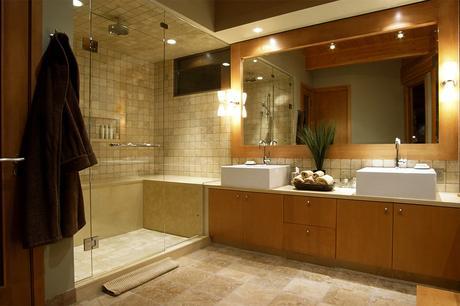
Here is a quick guide to understanding the legal requirements for bathroom lighting, which aims to answer any questions you might have, along with a number of resources where further and more in-depth information can be found. We've teamed up with luxury lighting specialists, Oberoi Brothers, to bring you this guide.
Understanding IP Ratings
In order to ensure that only light fixtures which are safe to fit within UK bathrooms are used, the IP rating scheme has been devised. To give it its full name, the Ingress Protection Scale was devised to measure and assess the amount of water and / or moisture able to get into a fitting or fixture and thus the amount of protection it provides home owners. Hence, each fitting sold here within the UK is so featuring a code which enables non-experts and non-electricians to buy the correct fittings and fixtures for the different rooms and appliances within their homes.
Following the acronym 'IP', the code featured on a fixture or fitting should then take the form of two digits. The first digit refers to how well a fitting or fixture is protected against solid objects. For example, it tells a buyer how well a fixture will protect against dust, fingers and most solid objects of varying sizes; the higher the number the better the fitting or fixture is protected against solid objects. Meanwhile, a fitting featuring an 'X' in place of a number tells a buyer that a fittings protection against solid objects has not been determined.
The second number provides a gauge of how well a fixture is able to protect all within it against liquids, including moisture. Again, the lower the number the less protection the fitting is able to provide. For example, a fitting with an IP liquid protection rating of only '1' will (when tilted to up to a 15 degree angle) protect against dripping water for a minimum of 10 minutes whilst a fitting or fixture featuring a liquid protection rating of '8' will continuously protect all within it whilst submerged entirely in water of up to one metre in depth.
When looking to purchase an appropriate and safe bathroom fitting or fixture, home owners should look to purchase lights and fittings with the highest IP rating possible. The actual regulations as to the IP rating required meanwhile will depend entirely on the 'zone' in which a light is intended to be fit within a bathroom - which is discussed and explained in more detail below. Meanwhile, to learn more about the Ingress Protection Scale, you can do so via the Protecting People website which is run by Ventcroft Ltd., a leading and independent UK maker and supplier of fire and security cables and alarm products.
Bathroom Lighting and the No Go Zones
To help ensure that individuals and families get and use the right lights, fittings and fixtures within their home bathrooms, the regulations stating what is safe and appropriate to be used is divided into categories. This is because there are areas in the standard bathroom in which it is more and in turn less safe to place fitted lighting. Hence, depending where a light is placed will depend on the fitting and what IP rating a fitting should bear in order to comply with UK regulations and be safe to use.
There are four zones within a bathroom and these are numbered 0 through to 3, depending on their proximity to bathroom appliances and the level of water and moisture the surfaces within each zone is likely to come into contact with. For this reason, each zone is extremely carefully calculated and measured, and it is of the utmost importance to follow these measurements. To ensure that you do so and because it is very difficult and potentially confusing (rather than clarifying) to do so without a visual aid in the form of a diagram, here at Oberoi Brothers Lighting we advise referring to the diagram featured via the Dealec website.
It is important to take a moment to study a diagram showing where each zone within a bathroom begins, ends and covers because (and as those who take this advice will see) each zone within a bathroom requires lights and fittings of a different and specific IP rating. Failure to adhere by the regulations established and upheld here in the UK when fitting bathroom lighting or tampering with a bathroom situated light fitting could mean breaking the law if you are not a qualified electrician. As well, it could void your home insurance and even place yourself and your family in danger.
More Information
For more information and a more extensive look at the regulations governing lighting used within bathrooms in homes here in the UK, you can find this and more via the Electrical Competent Person website, which has been a UK Government approved register and online resource since June 2014.
Meanwhile, to view, browse and shop for high quality and brilliantly designed bathroom lighting of all types, you can do so by browsing our bathroom lighting range here on the Oberoi Brothers website.
